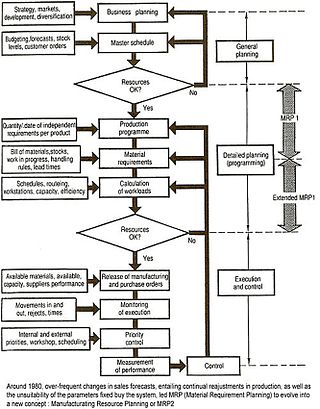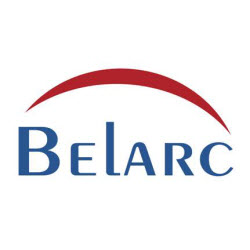
In computing, a legacy system is an old method, technology, computer system, or application program, "of, relating to, or being a previous or outdated computer system", yet still in use. Often referencing a system as "legacy" means that it paved the way for the standards that would follow it. This can also imply that the system is out of date or in need of replacement.

Configuration management (CM) is a process for establishing and maintaining consistency of a product's performance, functional, and physical attributes with its requirements, design, and operational information throughout its life. The CM process is widely used by military engineering organizations to manage changes throughout the system lifecycle of complex systems, such as weapon systems, military vehicles, and information systems. Outside the military, the CM process is also used with IT service management as defined by ITIL, and with other domain models in the civil engineering and other industrial engineering segments such as roads, bridges, canals, dams, and buildings.

A system administrator, or sysadmin, or admin is a person who is responsible for the upkeep, configuration, and reliable operation of computer systems, especially multi-user computers, such as servers. The system administrator seeks to ensure that the uptime, performance, resources, and security of the computers they manage meet the needs of the users, without exceeding a set budget when doing so.

The point of sale (POS) or point of purchase (POP) is the time and place at which a retail transaction is completed. At the point of sale, the merchant calculates the amount owed by the customer, indicates that amount, may prepare an invoice for the customer, and indicates the options for the customer to make payment. It is also the point at which a customer makes a payment to the merchant in exchange for goods or after provision of a service. After receiving payment, the merchant may issue a receipt for the transaction, which is usually printed but can also be dispensed with or sent electronically.
Autonomic computing (AC) is distributed computing resources with self-managing characteristics, adapting to unpredictable changes while hiding intrinsic complexity to operators and users. Initiated by IBM in 2001, this initiative ultimately aimed to develop computer systems capable of self-management, to overcome the rapidly growing complexity of computing systems management, and to reduce the barrier that complexity poses to further growth.
In the context of software engineering, software quality refers to two related but distinct notions:

Manufacturingresource planning is a method for the effective planning of all resources of a manufacturing company. Ideally, it addresses operational planning in units, financial planning, and has a simulation capability to answer "what-if" questions and is an extension of closed-loop MRP.
network]]s (LANs) up to wide area networks (WANs). Responsibilities may vary between organizations, but installing new hardware, on-site servers, enforcing licensing agreements, software-network interactions as well as network integrity and resilience are some of the key areas of focus.
Cincom Systems, Inc., is a privately held multinational computer technology corporation founded in 1968 by Tom Nies, Tom Richley, and Claude Bogardus.
Software asset management (SAM) is a business practice that involves managing and optimizing the purchase, deployment, maintenance, utilization, and disposal of software applications within an organization. According to ITIL, SAM is defined as “…all of the infrastructure and processes necessary for the effective management, control, and protection of the software assets…throughout all stages of their lifecycle.” Fundamentally intended to be part of an organization's information technology business strategy, the goals of SAM are to reduce information technology (IT) costs and limit business and legal risk related to the ownership and use of software, while maximizing IT responsiveness and end-user productivity. SAM is particularly important for large corporations regarding redistribution of licenses and managing legal risks associated with software ownership and expiration. SAM technologies track license expiration, thus allowing the company to function ethically and within software compliance regulations. This can be important for both eliminating legal costs associated with license agreement violations and as part of a company's reputation management strategy. Both are important forms of risk management and are critical for large corporations' long-term business strategies.

A computer appliance is a computer system with a combination of hardware, software, or firmware that is specifically designed to provide a particular computing resource. Such devices became known as appliances because of the similarity in role or management to a home appliance, which are generally closed and sealed, and are not serviceable by the user or owner. The hardware and software are delivered as an integrated product and may even be pre-configured before delivery to a customer, to provide a turn-key solution for a particular application. Unlike general purpose computers, appliances are generally not designed to allow the customers to change the software and the underlying operating system, or to flexibly reconfigure the hardware.

Intel Active Management Technology (AMT) is hardware and firmware for remote out-of-band management of select business computers, running on the Intel Management Engine, a microprocessor subsystem not exposed to the user, intended for monitoring, maintenance, updating, and repairing systems. Out-of-band (OOB) or hardware-based management is different from software-based management and software management agents.
Property Management Systems (PMS) or Hotel Operating System (HOS), under business, terms may be used in real estate, manufacturing, logistics, intellectual property, government, or hospitality accommodation management. They are computerized systems that facilitate the management of properties, personal property, equipment, including maintenance, legalities and personnel all through a single piece of software. They replaced old-fashioned, paper-based methods that tended to be both cumbersome and inefficient. They are often deployed as client/server configurations. Today, most next-generation property management systems favor a software as a service (SaaS) model sustained by web and cloud technologies.

Accounting software is a computer program that maintains account books on computers, including recording transactions and account balances. It may depends on virtual thinking. Depending on the purpose, the software can manage budgets, perform accounting tasks for multiple currencies, perform payroll and customer relationship management, and prepare financial reporting. The first accounting software was introduced in 1978. Since then, the accounting software has revolutionized from supporting basic accounting operations to performing real-time accounting and supporting financial processing and reporting. Cloud accounting software was first introduced in 2011, and it allowed to perform all accounting functions through the internet.
Business process management (BPM) is the discipline in which people use various methods to discover, model, analyze, measure, improve, optimize, and automate business processes. Any combination of methods used to manage a company's business processes is BPM. Processes can be structured and repeatable or unstructured and variable. Though not required, enabling technologies are often used with BPM.
Network management software is software that is used to provision, discover, monitor and maintain computer networks.

Belarc Inc. is an American software company. The company's products are used for software license management, configuration management, cyber security status, information assurance audits, IT asset management, and more.
Granular configuration automation (GCA) is a specialized area in the field of configuration management which focuses on visibility and control of an IT environment's configuration and bill-of-material at the most granular level. This framework focuses on improving the stability of IT environments by analyzing granular information. It responds to the requirement to determine a threat level of an environment risk, and to allow IT organizations to focus on those risks with the highest impact on performance. Granular Configuration Automation combines two major trends in configuration management: the move to collect detailed and comprehensive environment information and the growing utilization of automation tools.
Data center management is the collection of tasks performed by those responsible for managing ongoing operation of a data center. This includes Business service management and planning for the future.
In IT operations, software performance management is the subset of tools and processes in IT Operations which deals with the collection, monitoring, and analysis of performance metrics. These metrics can indicate to IT staff whether a system component is up and running (available), or that the component is behaving in an abnormal way that would impact its ability to function correctly—much like how a doctor may measure pulse, respiration, and temperature to measure how the human body is "operating". This type of monitoring originated with computer network components, but has now expanded into monitoring other components such as servers and storage devices, as well as groups of components organized to deliver specific services and Business Service Management).








